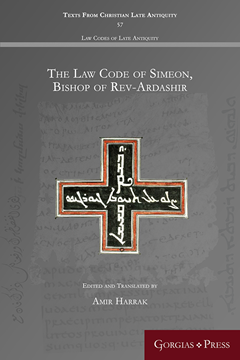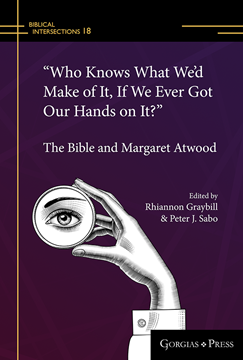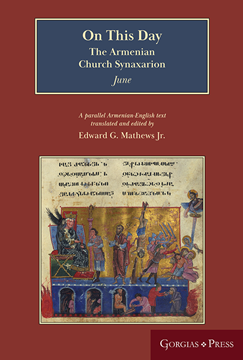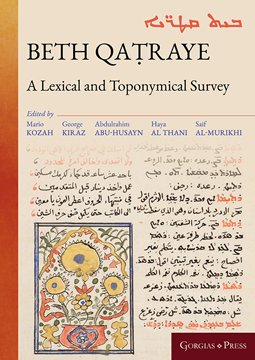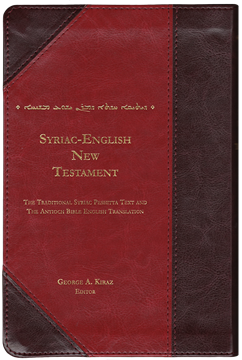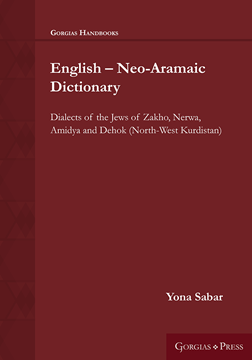The Law Code of Simeon, Bishop of Rev-Ardashir
Edited and Translated by Amir Harrak
Series: Texts from Christian Late Antiquity 57
ISBN: 978-1-4632-4134-6
The Law Code of Simeon of Rev-Ardashir, originally written in Persian, was translated into Syriac by a monk of Bēṭ-Qatrāyē. The Code's author, possibly to be identified with a rebellious metropolitan mentioned in the letters of Patriarch Īšoʿ-yahb III, aims to clarify theoretical scriptural law, and to address specific cases of inheritance law.
$48.40 (USD)
“Who Knows What We’d Make of It, If We Ever Got Our Hands on It?”
The Bible and Margaret Atwood
Edited by Rhiannon Graybill & Peter J. Sabo
Series: Biblical Intersections 18
ISBN: 978-1-4632-4135-3
In the nightstands of hotel rooms, kept under lock and key, in the poetry of a pre-apocalyptic environmental cult, and quoted by children, atheists, and murderers alike—the Bible is omnipresent in the work of Margaret Atwood. The Bible is found not only in her novels but also in her poetry, short stories, and non-fiction work. “Who Knows What We’d Make of It, If We Ever Got Our Hands on It?” assembles cutting edge literary and critical readings of Margaret Atwood and the Bible.
$158.00 (USD)
On This Day (June)
The Armenian Church Synaxarion (Yaysmawurkʿ)
Edited and Translated by Edward G Mathews Jr
Series: The Armenian Church Synaxarion 6
ISBN: 978-1-4632-4137-7
The Armenian Church Synaxarion is a collection of saints’ lives according to the day of the year on which each saint is celebrated. Part of the great and varied Armenian liturgical tradition from the turn of the first millennium, the first Armenian Church Synaxarion represented the logical culmination of a long and steady development of what is today called the cult of the saints. This volume, the first Armenian-English edition, is the sixth of a twelve-volume series—one for each month of the year—and is ideal for personal devotional use or as a valuable resource for anyone interested in saints.
$102.00 (USD)
Beth Qaṭraye
A Lexical and Toponymical Survey
By Dr Mario Kozah, George Anton Kiraz, Prof Abdulrahim Abu-Husayn, Haya Al Thani & Saif Shaheen Al-Murikhi
Series: Gorgias Eastern Christian Studies 58
ISBN: 978-1-4632-4139-1
This volume presents and analyzes information on the pre-Islamic and early Islamic historical geography and toponyms of the Beth Qaṭraye region as well as newly discovered vocabulary from a language referred to as Qaṭrāyīth (“in Qatari”) used by its inhabitants.
$55.00 (USD)
Syriac-English New Testament
The Traditional Syriac Peshitta Text and the Antioch Bible English Translation
General Editor George Anton Kiraz; Translated by Jeff W. Childers, J. Edward Walters, Daniel King, Robert A. Kitchen, Jerome Alan Lund & James Prather
ISBN: 978-1-4632-4160-5
After the success of the Antioch Bible, this publication is a new, historic edition of the Syriac-English New Testament in a single volume. The English translations of the New Testament Syriac Peshitta along with the Syriac text were carried out by an international team of scholars. NOTE: If you meant to order the beautiful gold gilded edition of this book, rather than the standard format, please see the link in the Overview text below.
From $30.00 (USD)
English - Neo-Aramaic Dictionary
Dialects of the Jews of Zakho, Nerwa, Amidya and Dehok (North-West Kurdistan)
By Yona Sabar
Series: Gorgias Handbooks 45
ISBN: 978-1-4632-4144-5
Based on Sabar's 2002 Jewish Neo-Aramaic dictionary, this dictionary serves a functional purpose for readers and scholars who would like to know the Neo-Aramaic vocabulary. It does not include grammatical or semantic details but does include the origin of the words, be it native Old Aramaic, and, in the case of loanwords, the original lending language, Arabic, Kurdish, Persian, Turkish, etc.
$55.50 (USD)
